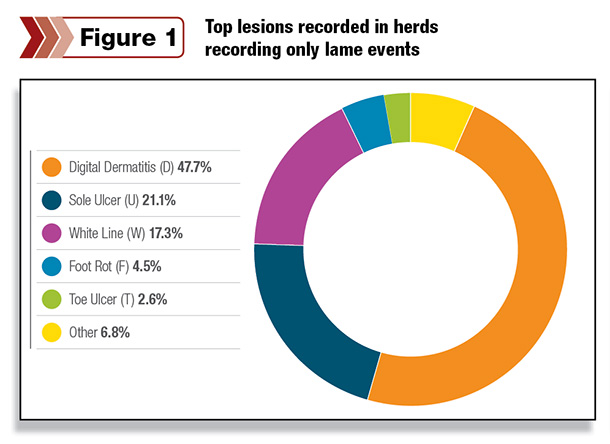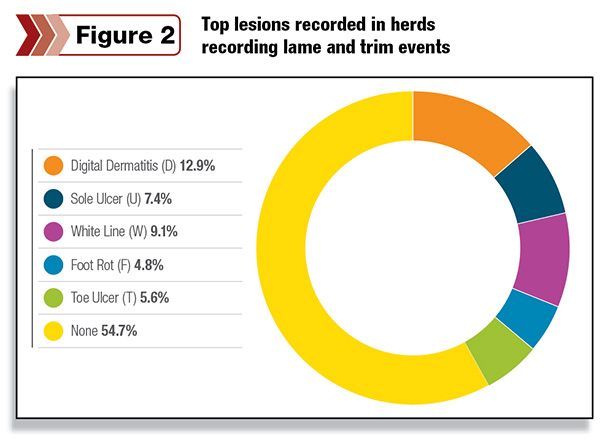Data collected from several large dairy herds is being used to benchmark claw lesions that lead to lameness, with digital dermatitis being the most common culprit. A recent study published in the Journal of Dairy Science details findings from an analysis of foot health records from 17 confinement dairies.
Objectives of this research were to merge claw lesion records from several dairy herds in order to establish a database that benchmarks major claw lesions, timing and possible reasons for why the lesions occur.
Claw lesion data – comprised of nearly 50,000 events from 17 dairies – was merged into one database. Among these dairies, 12 were freestall barns, two were dirt lots and three dairies were a combination of the two. Data originated from approximately 40,900 cows from herds ranging in size from 500 to 6,000 cows in nine states in the U.S. and two international herds located in the southern hemisphere.
The final database was partitioned and analyzed as two separate datasets. One set included eight herds recording only lame events (20,860 events), and the other set included the remaining nine herds recording both lame and routine trim events (27,646 events).

Findings among herds recording only lame events
Of herds that recorded only lame events, five types of lesions comprised 93.2 percent of the total lesions identified. The lesion type recorded most often on the dairies in the study was digital dermatitis (47.7 percent), followed by sole ulcer (21.1 percent), white line (17.3 percent), foot rot (4.5 percent) and toe ulcer (2.6 percent).
Based on this data, some observations were made.
• Distribution of the top five lesions differed among lactation number and lesion type. The ratio of infectious to non-infectious claw lesions decreased with an increasing lactation number (2.4 for first lactation, 1.6 for second lactation and 0.7 for third lactation-plus). Producer take-away: This observation indicates a need for dairy herd managers to focus on preventing infectious claw lesions in youngstock and non-infectious claw lesions in cows with more than one lactation.
• Infectious and non-infectious lesions differed across months, and the ratio of infectious to non-infectious differed within months. Infectious claw lesions were recorded more frequently during the cooler months of the year, whereas non-infectious lesions predominated during and after the warmer months.
• The distribution of the top five claw lesions differed both across and within days in milk (DIM) range. Nearly half (47.8 percent) of all events recorded were prior to 180 DIM, suggesting the need to focus on factors known to cause lameness between the dry period and peak milk production.
The two major claw lesions found in the first 120 DIM were digital dermatitis and sole ulcers. The average percentage of events recorded as digital dermatitis within the first 120 DIM was higher for cows in their first and second lactations compared to those in third lactation or more (63 percent, 61 percent and 39 percent, respectively).
However, more sole ulcer events were recorded for third lactation-plus cows compared to first-lactation and second-lactation cows during this same time period (29 percent, 14 percent and 15 percent, respectively).
Events recorded as digital dermatitis were evenly distributed across the 60-day increments of DIM, with the exception of third lactation-plus cows, which peaked at 23 percent in the first 60 DIM. In contrast, events recorded as sole ulcers and white line lesions followed the shape of a typical lactation curve and peaked between 121 and 180 DIM.
Producer take-away: Differences in the distribution of infectious and non-infectious claw lesions indicate that these lesion classes require different methodical approaches when it comes to identifying causative factors and subsequently making management recommendations to reduce herd lameness.

Findings among herds recording lame and trim events
Setting aside the 54.7 percent of events recorded as “none” (claws examined and no lesion was found), the top five claw lesions found in herds that recorded both lame and trim events included digital dermatitis (12.9 percent), white line (9.1 percent), sole ulcer (7.4 percent), toe ulcer (5.6 percent) and foot rot (4.8 percent).
When looking at the distribution of claw lesions recorded (excluding “none”), digital dermatitis was the major claw lesion recorded and comprised 32.4 percent of the top five lesions.
Based on this data, observations were made.
• The distribution of the top five lesions differed among lactation number and lesion type. Similar to herds recording only lame events, the ratio of infectious to non-infectious lesions decreased as number of lactation increased (1.6, 1 and 0.4 for first lactation, second lactation and third lactation-plus, respectively).
• The distribution of the top five claw lesions differed both across and within DIM range. Similar to herds recording only lame events, a high proportion of events in the first 60 DIM were infectious claw lesions relative to non-infectious claw lesions (22.2 percent vs. 14.5 percent, respectively).
• The major infectious claw lesions recorded in the first 60 DIM were digital dermatitis and foot rot. Digital dermatitis was found to be higher within 60 DIM in first-lactation and second-lactation groups (19.1 percent, 25.6 percent) compared to third lactation-plus (15.9 percent).
Roughly 40 percent of foot rot was recorded in the first 60 DIM, most of which was recorded for first-lactation cows versus second lactation or third lactation-plus (30.5 percent, 17.3 percent and 12.4 percent, respectively).
Producer take-away: This data supports the need to focus on management, prevention and treatment of digital dermatitis and foot rot prepartum to avoid onset and spread of these infectious claw diseases in early lactation, especially in first-lactation cows.
• Sole ulcers and toe ulcers represented the majority of non-infectious claw lesions, increasing with higher lactation number (9.8 percent in first lactation, 15.5 percent in second lactation and 27 percent in third lactation-plus).
Conclusions
This data provides an initial database for benchmarking claw lesions on commercial dairies. White line, sole ulcer, toe ulcer, digital dermatitis and foot rot comprised 93 percent of lesions for herds recording only lame events and 40 percent of lesions in herds recording lame and trim events (excluding routine trims with no lesion). The ratio of infectious to non-infectious lesions decreased with increasing lactation number in both datasets.
Digital dermatitis and foot rot were greatest in the first 60 DIM and differed across parity. Non-infectious lesions were highest following heat stress, whereas infectious lesions were highest during the coolest quarter of the year.
Infectious claw lesions, namely digital dermatitis and foot rot, appear to be the most troublesome in the first 120 DIM, especially in first-lactation cows. Conversely, non-infectious claw lesions (white line, sole ulcer and toe ulcer) were largely associated with cows in their second and third lactations and were most commonly observed at or near peak milk production and during or shortly after periods of heat stress.
Efforts to reduce lameness in dairy cattle remain a priority as the industry strives to enhance animal well-being. Foot health records are useful in monitoring the degree of lameness within dairy herds and, perhaps more importantly, providing insight into the underlying factors causing lameness.
Diagnosing and recording the lesions allows consultants, nutritionists and veterinarians to fine-tune their investigation into the risk factors for the various lesions. In the past, only a limited amount of field data has existed within the industry to utilize for benchmarking major claw lesions present on confinement dairy operations.
More lameness resources
Over the years, a methodical system has been developed to better understand the extent and causes of lameness. Locomotion scoring has become a globally adopted practice to determine the prevalence and severity of lame cows.
Research in 2007 demonstrated that locomotion scoring is a useful tool to identify cows with painful lesions within the dairy herd. The Dairy Claw Lesion Identification poster, developed through a combined effort by the International Lameness Committee and Zinpro Corporation, provides one of the most comprehensive approaches to help properly identify common claw lesions.
It is recommended to utilize this resource to properly diagnose and keep adequate records on claw lesions. This will enable dairy operators to orchestrate a lameness mitigation plan in order to successfully prevent, control and manage the specific claw lesions impacting herd performance. PD
Jeffrey DeFrain has a Ph.D. in dairy nutrition from South Dakota State University and is employed by Zinpro Corporation as a research nutritionist based in Kansas.
References omitted due to space but are available upon request. Click here to email an editor.
Additional resources: Monitor lameness in your herd with Zinpro Corporation’s locomotion scoring and lesion identification tools.

Jeffrey DeFrain
Research Nutritionist
Zinpro Corporation






